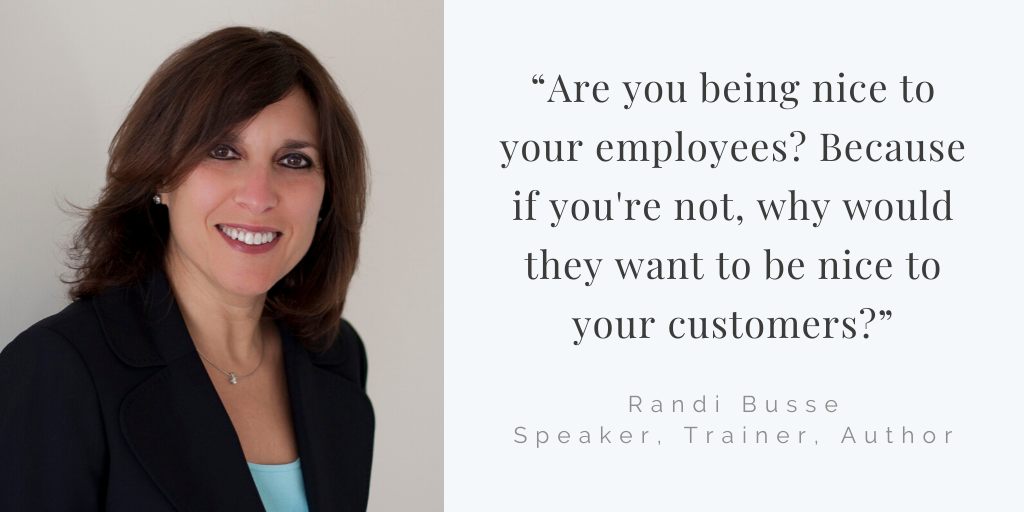Advertising disclosure: This blog participates in the Amazon Services LLC Associates Program, an affiliate advertising program designed to provide a means to earn fees by linking to Amazon.com and affiliated sites.
We've all received customer service from an employee who doesn't care.
They are content to do the minimum. They don't seem invested or happy to be there. Anything outside a routine transaction is met with indifference, and they certainly don’t make an effort to solve problems.
If you're a customer service leader, these employees are frustrating.
I recently spoke with Randi Busse, a customer service speaker and trainer, and co-author of Turning Rants Into Raves. Busse has some fantastic advice for getting employees to take ownership.
Here are just a few topics we covered:
The difference between Rant and Rave employees
How to hire employees who will take ownership
What can you do about employees who don't take ownership
How leaders can encourage more ownership
The critical importance of empowerment
How to encourage a culture of ownership
Watch the full interview here or scroll below to read the highlights.
In this interview with customer service expert Randi Busse, we discuss how to get customer service employees to take ownership.
Who are Rant and Rave?
These are personas of employees who work in every organization
Rant is the employee who is just there for a paycheck.
Rave is happy to be there, is engaged, and thinks like an owner of the business.
Busse brings life-sized posters of Rant and Rave with her to speaking engagements, which is a fun visual. She showed a miniature version of the two characters during our conversation.
Do we hire Rants and Raves, or do we create them?
It's both.
According to Busse, some employees show up as Rave at an interview. They give all the right answers, and you get a good vibe from them. Then later on they turn into Rant.
It could be that they were always a Rant, and just put on a good show in the interview. (Note: If this happens to you, there's a good chance your hiring process is broken. Check out these hiring resources to help you hire more Raves.)
Or it could be that they were created by leaders who create an environment that doesn't inspire them to do good work.
"The good new is," says Busse, "that no matter how a Rant is created, 9.5 times out of 10, we can convert that Rant into a Rave."
What can you do if you have Rants on your team?
Busse suggests leaders need to start by looking at themselves in the mirror.
"A leader is sometimes Rant. And if the leader is Rant, it goes without saying that the employees are going to be Rants also."
Examples include treating employees poorly or getting upset and talking down to employees. Employees will also observe your interactions with customers. If you act like a Rant when serving a customers, employees will pick that up.
Many managers don't realize they are accidentally training their employees to say the wrong thing to customers.
What else can leaders do to encourage Raves?
"Acknowledging Rave behavior is really important," says Busse. "I'm a fan of giving positive, specific feedback."
Busse encourages leaders to point out exactly what an employee did well, so they know they're on the right track and are likely to do that again in the future.
For example, if an employee does a great job serving an upset customer, you might pull them aside and commend them for keeping their cool and still smiling when the customer was being unreasonable. This sends a message to the employee that they did the right thing and their work is valued.
Busse also reminds us that it's important to hold people accountable for exhibiting Rant-live behaviors.
"Unfortunately," says Busse, "I don't see that happening as often as it should in businesses." Tolerating behaviors like coming in late, being rude to customers, and not trying hard sends the message to that employee and others that being a Rant is okay.
How do leaders balance accountability and being a Rave?
"We need to trust our employees, and then we need to empower them to make decisions as if they were the owner of the company," says Busse.
Empowerment starts by being really clear about what you want employees to do. One way to do that is by creating a customer service vision.
Some leaders assume that great customer service is just a matter of common sense, without realizing that customer service expectations can vary from company to company. And in some cases, that employee never had a mentor to show them the right way to do things.
Get more ideas for empowerment from the related article, how to empower customer service employees.
Additional Resources
Here are some additional resources to help you.
Busse shares her phone number in the video so you can contact her for help.
You can learn more from Busse's book, Turning Rants into Raves.
Get more ideas and resources from Busse's website.
Finally, you can learn more about taking ownership from this training video.



